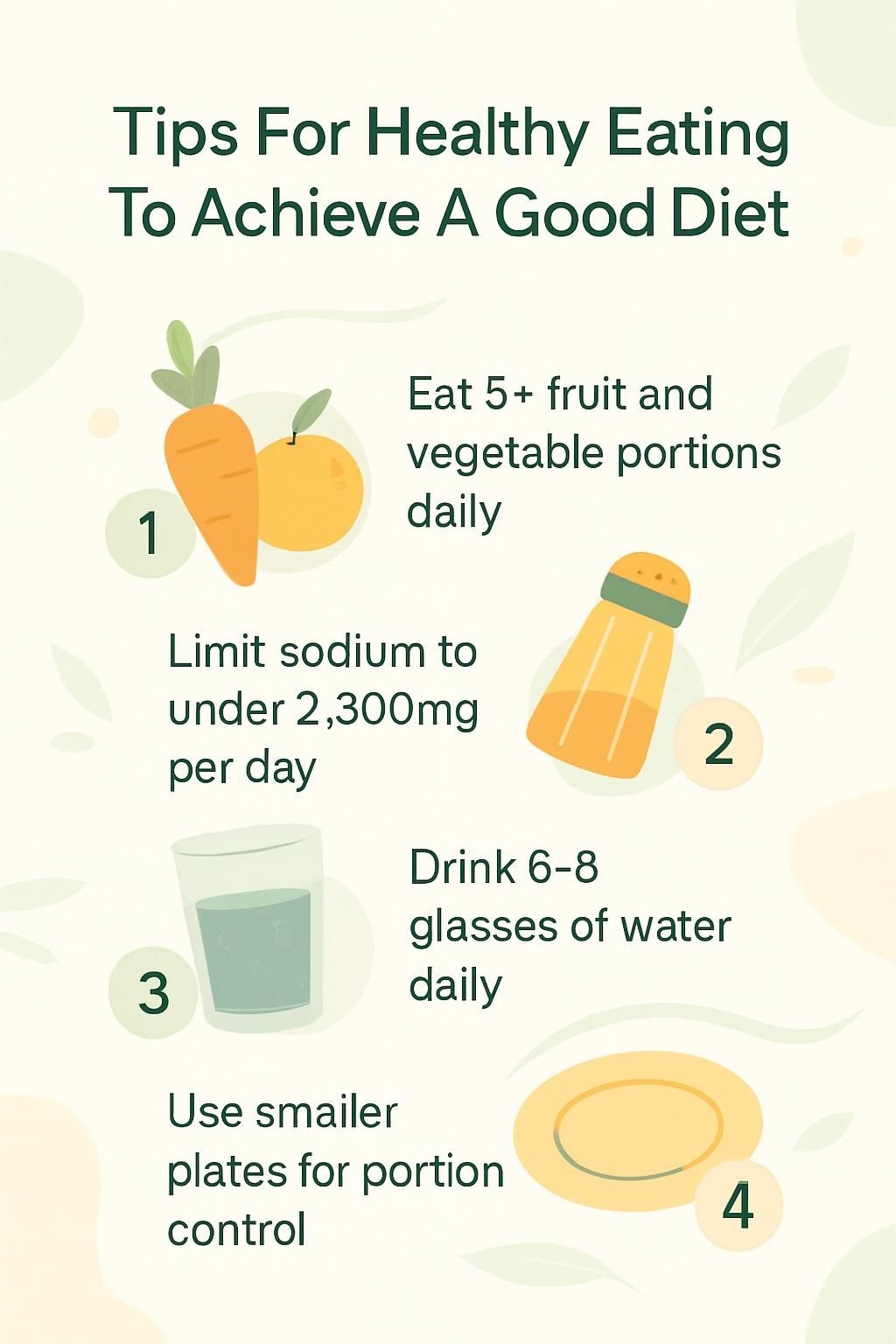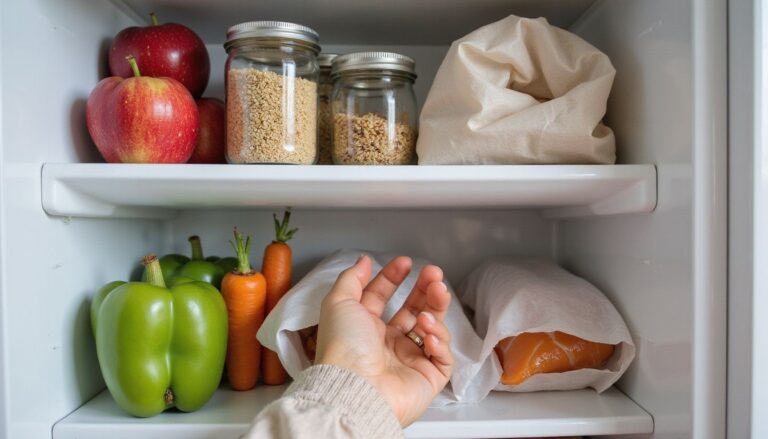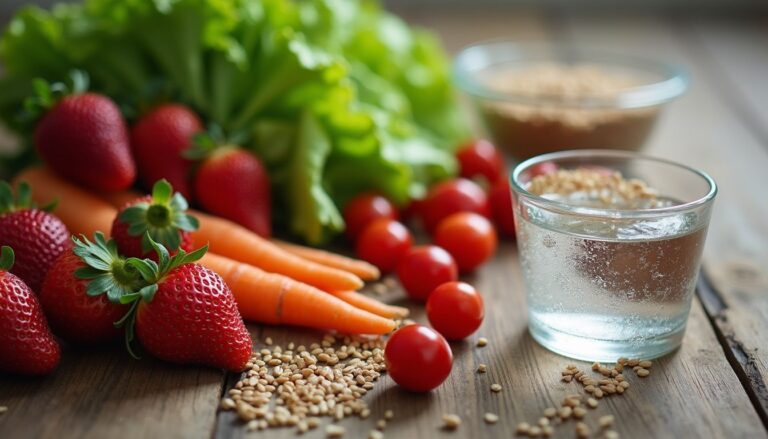Tips For Healthy Eating To Achieve A Good Diet
Our Nutrition Assistant AI Suite will transform your body. You will lose fat, get toned, and build muscle. Gain confidence and optimal health.
Struggling to stick to a good diet or keep up healthy eating during busy days? Small, steady changes can shift your eating plan without stress. Research links eating at least five servings of fruits and vegetables each day with a lower risk of heart disease and obesity.
This guide gives you clear, practical steps. You will learn how to build a balanced diet, plan better meals, and make simple swaps that add up. Use these tips to create healthy habits that last.
Keep reading if you want straightforward steps you can start today.
Key Takeaways
- Eating at least five servings of fruits and vegetables daily, as suggested in the Dietary Guidelines for Americans 2020-2025, helps lower the odds of heart disease and obesity.
- Keep saturated fat under 30 grams for men and 20 grams for women per day, and sodium below 2,300 milligrams daily to support heart health, based on the DASH plan.
- Choose high fiber starchy foods like brown rice and whole wheat pasta for over one third of meals. These support digestion and weight control.
- Drink six to eight glasses of water a day instead of sugary drinks. Too much added sugar raises obesity rates and harms dental health.
- Use meal planning, smaller plates for portion control, and more home cooking. These habits save money and cut waste, with U.S. households discarding up to 40% of food.

Why Is a Balanced Diet Important?

A balanced diet gives your body the nutrients it needs to work well and stay healthy. It supports steady energy, a strong immune system, and a healthy weight.
What Is a Balanced Diet?
A balanced plate includes foods from the five main food groups. The Eatwell Guide and similar tools show general portions: fruits, vegetables, whole grains like brown rice and oats, dairy foods or fortified alternatives, lean protein such as fish, poultry, beans, or tofu, and healthy fats like nuts and vegetable oils.
Variety matters. Eating across these groups helps you get vitamins, minerals, protein, and fiber. Many experts suggest about one third of your meals come from high fiber starchy foods such as potatoes, pasta, oats, and whole grain bread.
Getting your 5 a day supports vitamin and mineral needs that help bones, skin, and vision. Building meals this way also lowers the risk for heart disease, type 2 diabetes, stroke, and some cancers.
What Are the Benefits of Healthy Eating?
Healthy eating supports a longer life and fewer serious health problems. Diets rich in fruits, vegetables, whole grains, low fat dairy, and foods with omega-3 fatty acids, which are heart supportive fats found in fish and some plants, are linked to lower rates of heart disease, high blood pressure, type 2 diabetes, and obesity.
Following national guidance to eat at least five servings of produce daily supports blood pressure and bone health. Cutting back on saturated fat and added sugar helps manage cholesterol, which reduces heart risk.
The DASH diet, created to help control hypertension, which means high blood pressure, limits sodium and focuses on fiber rich foods like legumes, nuts, seeds, and whole grains. Many people also report better energy and mood when they limit heavily processed foods.
Key Components of a Healthy Diet
A healthy diet fuels your day and protects long term health. Small upgrades in what you eat and drink can lower disease risk and improve how you feel.
How Many Fruits and Vegetables Should I Eat Daily?
Aim for at least five servings of a variety of fruits and vegetables each day. Fresh, frozen, canned, dried fruit, or juice can all count.
One serving is about 80 grams for fresh, canned, or frozen produce and 30 grams for dried fruit. One small glass of juice, about 150 milliliters, counts as one serving, but only once per day due to concentrated sugar.
If you follow a 2,000 calorie eating plan, the DASH approach suggests four to five servings of vegetables and four to five servings of fruit daily.
Eat the rainbow each day, and your heart gets a boost.
Try bananas over cereal or pineapple chunks in yogurt. Swap processed snacks for peas, sliced peppers, or dried fruit to reach your goal.
What Are High-Fiber Starchy Foods?
High fiber starchy foods are your main energy source and support digestion. These include bread, rice, potatoes, pasta, and cereals.
Choose whole grain or higher fiber versions, such as brown rice and whole wheat pasta. They help you feel full longer and may help with weight control. Include at least one high fiber starch at each main meal. Keep added butter, cream, or cheese light during cooking to limit saturated fat.
Which Lean Protein Sources Are Best?
Lean protein builds and repairs tissues with fewer calories from fat. Fish is a strong choice. Eat two portions per week, with one being oily fish such as salmon, trout, herring, sardines, pilchards, or mackerel for heart supportive fats.
Non-oily options like cod, haddock, tuna packed in water, plaice, hake, skate, or coley add variety. Choose skinless poultry and bake or grill instead of frying. Beans, lentils, and peas add protein and fiber while limiting calories. Eggs offer high quality protein, and tofu is a good plant option. Nuts and seeds are nutrient dense. Keep portions small since they are high in calories.
Eating fewer fatty meats lowers saturated fat intake, which supports heart health, as noted by the American Heart Association.
What Are Healthy Fats and Where Do They Come From?
Healthy fats are mostly unsaturated fats. These come from nuts, seeds, avocados, and vegetable oils such as olive or canola oil. They help maintain healthy cholesterol levels and lower heart risk.
Limit tropical oils like coconut and palm oil, which are high in saturated fat. Keep saturated fat under daily limits, about 30 grams for men and 20 grams for women. Children need even less. Simple swaps help. Use olive oil instead of butter for cooking, or top salads with avocado in place of creamy dressings.
How Much Water Should I Drink Each Day?
Drink six to eight glasses of fluids daily, not counting water from food. Water is best for hydration. Lower fat milk and low sugar smoothies can also fit. Sugary drinks add calories and can raise blood pressure over time.
Choosing water instead of soda supports weight goals and makes eating well simpler. Now, see which fats and foods to limit.
Foods to Limit for a Healthy Diet
Certain foods raise the risk for heart disease and high blood pressure. Learning where salt, added sugar, and unhealthy fats hide helps you make better choices.
Which Sources of Saturated Fats Should I Reduce?
Saturated fat is a type of fat that raises LDL cholesterol, the kind that can clog arteries. Limit fatty meats such as sausages, bacon, and lamb. Cut back on full fat dairy, including hard cheese, butter, cream, and whole milk. Lard, pies, and many pastries add more saturated fat.
Cakes and biscuits often have hidden saturated fats that can push you above safe limits, 30 grams for men and 20 grams for women per day. Choosing lower fat versions and lean cuts helps you protect your heart.
Why Should I Avoid Added Sugars and Sugary Drinks?
High intake of added sugars leads to weight gain and tooth decay. Sodas, energy drinks, and sweet teas add calories without nutrition. Guidelines suggest limiting added sugars to help with weight control.
Check food labels for hidden sugars. Pick water over sugary drinks to protect your teeth and lower calorie intake. This shift also supports heart health and more stable energy.
How Much Salt Is Safe to Consume Daily?
Most adults should keep salt to no more than 6 grams per day. The DASH plan recommends less than 2,300 milligrams of sodium daily, and 1,500 milligrams for greater blood pressure benefits. About 75 percent of the salt you eat comes from processed foods like canned soups, smoked fish, bakery goods, and ready meals.
A food is high in salt if it has more than 1.5 grams of salt per 100 grams. Too much salt raises blood pressure, which increases the risk of heart disease and stroke. Checking labels and cooking at home gives you more control.
Why Minimize Processed Food Consumption?
Processed foods often contain added sugars, saturated fats, and lots of salt. Since most dietary salt comes from packaged foods, frequent use can push your intake past safe limits.
Choosing more whole foods can lower heart risk and support weight goals. Nutrition models like the food pyramid and MyPlate point you to vegetables, fruits, lean protein such as eggs or soy, nuts and seeds, and whole grains in place of packaged snacks and desserts.
Tips for Building Healthy Eating Habits
These 8 tips for healthy eating make daily choices easier. Use them to build a pattern that fits your life.
How Can I Base Meals on Whole Grains and Lean Proteins?
Whole grains and lean proteins form a steady base for meals. They help you feel full and keep energy even.
- Choose whole grain staples like brown rice, whole wheat pasta, and oatmeal for over one third of your daily intake.
- Include a high fiber starch such as quinoa or whole grain bread at each main meal.
- Rotate protein sources, including seafood, skinless poultry, eggs, beans, soy, nuts, and seeds.
- Bake, roast, or grill instead of frying to limit added fat.
- Add beans and lentils to soups, bowls, and salads to boost fiber and plant protein.
- Pair grains with protein, such as scrambled eggs on whole grain toast or grilled fish with quinoa.
- Use the MyPlate Plan to guide portions within your calorie needs.
- I swapped white bread sandwiches for brown rice and roasted turkey. Afternoon cravings dropped.
These steps help you build balanced meals that support heart health and steady progress.
How Do I Add Fruits and Vegetables to Every Meal?
Once your base is set, add color and crunch. Small changes help you reach your 5 a day goal.
- Top oatmeal or cereal with sliced berries or banana.
- Snack on carrot sticks, cherry tomatoes, or apple slices instead of salty fries.
- Pack lunches with leafy greens and mixed veggies. Choose fruit canned in water or 100% juice.
- Stir frozen peas or spinach into pasta sauces or soups.
- Sauté vegetables with a light spray or a teaspoon of oil.
- Bake apples with cinnamon for a simple dessert instead of packaged sweets.
- Add tomatoes, onions, or mushrooms to sandwiches and wraps.
- Try a new vegetable each week. Roasted broccoli replaced canned green beans at my house, and flavor improved.
- Pick fresh, frozen, or low sodium canned options. Use herbs for taste without extra butter.
These ideas raise fiber, vitamins, and minerals while keeping meals satisfying.
What Are Healthy Snack Alternatives to Processed Options?
Snacks can fill nutrient gaps if you choose well. Focus on fiber, protein, and healthy fats.
- Grab a small handful of almonds, walnuts, or sunflower seeds for fiber and healthy fats.
- Choose fresh fruit such as apples or bananas to satisfy a sweet tooth.
- Pair raw vegetables with low fat cheese or hummus.
- Roast chickpeas for a crunchy, high fiber snack.
- Pick low fat yogurt with berries for protein and calcium.
- Bake simple snacks at home using less butter and more fruit or vegetables.
- Enjoy air popped popcorn without butter or heavy salt for a whole grain option.
- Can fruit at home without added sugar if you have the tools and time.
- Drink water or unsweetened tea instead of sugary drinks.
I switched from soda to water at work. Cravings eased, and it was easier to skip vending machine snacks.
How Can Meal Planning Help Avoid Unhealthy Choices?
Planning ahead removes guesswork and reduces last minute takeout. It also improves variety and balance.
- Plan meals with high fiber foods, such as whole grains and vegetables, to stay full longer.
- Shop with a list to avoid impulse buys high in sugar or saturated fat.
- Include lean protein and at least five servings of vegetables and fruits throughout the day.
- Cook once for multiple meals. Having ready options helps you pass on fast food.
- Use a food diary to spot patterns and gaps in your diet.
- Control portions and salt when you cook at home.
- Build your list from planned meals to cut waste. U.S. households throw away 30 to 40 percent of their food.
- Replace sugary drinks with water or low sugar smoothies in your plan.
- Meal prep creates a routine that supports weight goals, whether you need to lose or maintain weight.
Meal planning saves money, reduces stress, and strengthens healthy habits.
Why Is Portion Control Important?
Portion control helps match calories to your needs. It supports a good diet and steady progress.
What Are Simple Ways to Avoid Overeating?
Small daily habits can prevent overeating and make mindful eating easier.
- Use smaller plates and bowls to guide portions.
- Eat slowly, and set your fork down between bites.
- Limit comfort foods to once a week or choose a smaller amount.
- Swap high calorie ingredients for lighter options, like using nonfat milk instead of whole milk.
- Fill up on high fiber foods such as whole grains and vegetables.
- Drink a glass of water before meals.
- Plan meals with recipes that support weight goals.
- Compare calories. A lighter mac and cheese can save over 200 calories per serving.
- Avoid eating from large packages. Serve a portion, then put the rest away.
- Pick snacks with fiber or protein, such as fruit or yogurt, instead of ultra processed items.
How Does Staying Active Support Healthy Eating?
Movement and meals work as a team. Exercise helps your body use nutrients well and keeps mood steady.
What Are the Benefits of Regular Physical Activity?
Regular activity burns calories, preserves muscle, and supports a healthy weight. It also boosts mood and energy. The Centers for Disease Control and Prevention notes that children need at least 60 minutes of activity daily.
Active people have lower risks of heart disease, type 2 diabetes, and some cancers. Everyday movement, like walking or biking, strengthens bones. Pairing exercise with fiber rich foods supports digestion and long term health.
How Can Diet and Exercise Work Together for Best Results?
You gain weight if you eat more calories than you burn. You lose weight if you burn more than you eat. Balanced meals plus activity help your body use nutrients for energy, build muscle, and burn fat more efficiently.
Adults can aim for at least 150 minutes of moderate exercise per week with a diet rich in whole grains, fruits, lean proteins, and healthy fats. This approach can help prevent diabetes, heart disease, and issues tied to being underweight.
Special Considerations for Different Dietary Needs
Your needs may shift with health conditions, goals, or life stages. The right plan should be flexible and practical.
What Are Diet Tips for Weight Loss or Maintenance?
Weight control comes from smart choices about what and how much you eat. These steps help you build habits you can keep.
- Match daily calories to your needs. Many men need about 2,500 calories per day, many women need about 2,000.
- Use a BMI calculator or trusted weight loss plans to set a safe target.
- Base meals on high fiber foods such as oats, brown rice, whole wheat pasta, and beans.
- Eat at least five servings of fruits and vegetables daily.
- Choose lean proteins like chicken breast, turkey, fish, tofu, or lentils.
- Drink water, six to eight glasses a day, instead of sugary drinks.
- Use smaller plates to help with portion control.
- Plan meals so you avoid processed options high in fat and added sugars.
- Cook more at home to control ingredients and save money.
- Track food with an app or journal to see patterns and adjust.
- Make gradual changes. Slow progress is easier to keep long term.
How Can I Eat for Heart Health and Reduce Cardiovascular Risk?
Food choices affect blood pressure, cholesterol, and overall heart risk. Use these actions to support your heart.
- Try the DASH eating plan, ranked highly for heart health in 2025. It is flexible and does not require special products.
- Eat at least five servings of fruits and vegetables daily.
- Add high fiber foods like whole grains, beans, lentils, oats, and brown rice.
- Choose lean proteins such as fish, skinless chicken, tofu, or beans.
- Use healthy fats from avocados, olive oil, nuts, and seeds.
- Limit sodium to under 2,300 milligrams per day. Flavor foods with spices and herbs.
- Avoid sugary drinks that can raise triglycerides.
- Cut back on processed foods that often contain unhealthy fats and extra salt.
- Drink water regularly through the day.
- Plan meals around whole grains and lean proteins instead of convenience foods.
These habits support healthy cholesterol and blood pressure, which lowers cardiovascular risk.
What Nutritional Needs Are Important for Managing Diabetes?
Food choices play a key role in blood sugar control. Balanced meals and steady portions help your body manage glucose.
- Limit free sugars and added sugars. Check labels and avoid sugary drinks and desserts. Aim for less than 10% of calories from added sugars.
- Include high fiber foods at meals. Whole grains, beans, fruits, and vegetables help stabilize glucose.
- Choose lean proteins such as skinless poultry, fish, tofu, or legumes.
- Use healthy fats like nuts, seeds, avocados, and olive oil instead of butter or lard.
- Manage sodium by limiting processed foods. Many adults should keep sodium under 2,300 milligrams daily.
- Drink enough water unless your clinician recommends otherwise.
- Watch portion sizes to prevent overeating and support weight goals.
- Plan meals with tools such as MyPlate or the Healthy Eating Plate to balance carbohydrates through the day.
- Reduce highly processed foods that can hide sugars, unhealthy fats, and excess salt.
Many people find success by tracking meals to stay consistent. Work with a healthcare professional for a plan that fits your treatment.
Budget-Friendly Ideas for Healthy Eating
Eating well can fit a tight budget. Smart shopping and simple cooking techniques stretch dollars without sacrificing nutrition.
What Are Affordable Options for Fruits and Vegetables?
Produce does not have to be expensive. Use fresh, frozen, canned, dried, and juice options to meet your needs year round.
- Buy fresh produce in season for lower prices.
- Choose frozen vegetables or fruit without added salt, sauces, or sugar.
- Pick canned vegetables labeled no salt added or low sodium.
- Select canned fruit packed in water or 100% juice rather than syrup.
- Look for bulk sales at grocery stores and farmers markets.
- Try store brands for steady savings.
- Stock up on shelf stable dried fruit when on sale.
- Use budget friendly staples like potatoes and carrots for fiber and vitamins.
- Use coupons and loyalty programs to reduce costs.
- Choose no sugar added juices if you include juice.
- Skip pre cut produce, which usually costs more.
How Can Preparing Meals at Home Save Money?
Home cooking increases control over ingredients, portions, and cost. It also reduces fees tied to takeout.
- Cook larger batches and use leftovers for lunches or future dinners.
- Base meals on whole grains, beans, and seasonal produce. Items such as oats, brown rice, lentils, and canned beans are often under two dollars per pound.
- Plan meals before shopping so every ingredient serves a purpose.
- Buy family packs of items like chicken breasts or frozen vegetables when on sale.
- Avoid delivery and service fees by cooking at home.
- Track receipts to spot spending patterns and adjust.
- I saved about thirty dollars a week by cooking my own dinners instead of ordering out.
Preparing most meals at home supports nutrition and your wallet.
How Does Proper Meal Planning Reduce Food Waste?
Planning helps you buy the right amount and use what you purchase. This saves money and cuts waste.
- Make a weekly plan so you know which ingredients you will use.
- Write a shopping list from your plan and stick to it.
- Store perishables at eye level so you use them on time.
- Turn leftovers into new meals, such as a chicken salad or stir fry.
- Track meals with a diary to avoid buying extras you will not eat.
- Cook amounts that match how much your household needs.
- Freeze extra portions or produce you cannot use soon.
- Rotate pantry items using first in, first out.
- Plan around seasonal produce, which often lasts longer.
- Prioritize items close to their use by date.
- Do a quick weekly inventory and plan meals to use remaining items.
These steps make it easier to eat well while reducing food waste.
Tools and Resources for Healthy Eating
A few trusted tools can make planning and tracking easier. Use them to build skills and stay motivated.
What Is MyPlate and How Does It Guide Balanced Eating?
MyPlate, a USDA guide created in 2011, shows how to divide your plate among five food groups: fruits, vegetables, grains, protein foods, and dairy. The visual suggests half your plate be fruits and vegetables, one quarter whole grains, and one quarter lean proteins.
The MyPlate Plan adjusts advice by age, sex, height, weight, and activity. For example, many girls ages 9 to 13 need around 5 ounces of protein daily, while boys may need up to 6.5 ounces. Following these visuals helps you stay within your calorie needs.
How Does the Healthy Eating Plate Help?
The Healthy Eating Plate offers a simple picture for balanced meals. Fill half your plate with vegetables and fruits, with more space for vegetables. Use one quarter for whole grains and one quarter for healthy proteins like fish, beans, or poultry. It encourages healthy fats such as olive oil and limits trans fats and butter.
It also reminds you to drink water instead of sugary drinks. Potatoes are not counted as a vegetable in this model because they can raise blood sugar. Researchers at Harvard T.H. Chan School of Public Health developed this guide based on scientific evidence. I noticed better energy after shifting more plate space to greens and lean protein.
| Portion | Food Type | Example |
|---|---|---|
| 1/2 Plate | Vegetables and Fruits | Spinach, Broccoli, Berries |
| 1/4 Plate | Whole Grains | Brown Rice, Quinoa |
| 1/4 Plate | Lean Proteins | Beans, Chicken Breast |
| Small Amount | Healthy Fats | Olive Oil |
| Drink Choice | Water | Plain or Infused |
This approach makes portion control easier without complicated calorie math.
What Apps and Tools Can Help with Meal Tracking and Planning?
Digital tools can help you track meals, build grocery lists, and follow your plan. Pick one or two you can use every day.
- My Food Diary lets you log meals and drinks; it helps you spot patterns like frequent snacking or low vegetable intake.
- MyPlate from USDA offers free tracking and tips based on national guidelines from 2020 to 2025.
- The Healthy Eating Plate visual is easy to print and post for quick reference.
- Rethink Your Drink tools can help reduce added sugars in your beverages.
- How to Reduce Sodium shows lower sodium swaps and lists sodium per serving.
- Good Nutrition Starts Early offers family friendly recipes and shopping lists.
- Many planning apps save favorite recipes and build grocery lists from your menu.
- Barcode scanners in food diaries show calories, fiber, and added sugars at a glance.
- Some apps connect sleep tracking with your food diary, which may support healthier choices.
- Apps that sync with activity trackers show how exercise and nutrition work together, which can encourage better portion control.
Common Myths About Healthy Eating
Myths can make healthy choices confusing. Clearing them up makes space for a simple, balanced eating style.
What Are the Truths About Fat and Carbohydrates?
Fat and carbohydrates both belong in a healthy diet. Carbohydrates in starchy foods like potatoes or whole grains provide about 4 calories per gram, while fat provides 9 calories per gram. High fiber starchy foods should be a steady part of your eating pattern.
Choose mostly unsaturated fats from vegetable oils, nuts, and avocados. Reduce saturated fat from butter and fatty meats to help lower LDL cholesterol. Swapping chips fried in palm oil for baked sweet potato with olive oil is one simple move.
Are
Are all diets sold as healthy actually good for you? Many popular plans cut entire food groups or promise fast results. These plans often lack variety and may miss key nutrients.
A balanced diet is a better target. It includes fruits and vegetables, whole grains, lean proteins like fish, and healthy fats. Most women need about 2,000 calories per day and most men need about 2,500, though needs vary. Restrictive plans can drain energy. I tried a strict low carb plan once and felt tired during workouts because I lacked starchy foods for fuel.
Not every trend follows evidence based guidance, such as eating at least five servings of produce daily and keeping salt under six grams per day. Choose eating patterns with strong research rather than quick fixes.
Health disclaimer: This article is for education, not medical advice. For personal guidance, talk with a registered dietitian or your healthcare professional.Sources: Dietary Guidelines for Americans 2020-2025, American Heart Association, Centers for Disease Control and Prevention, Harvard T.H. Chan School of Public Health, DASH eating plan.
FAQs
1. What are simple tips for healthy eating to achieve a good diet?
Eat more vegetables, fruits, and whole grains each day. Choose lean meats like poultry or fish instead of processed options. Limit foods high in added sugars and salt. Drink water often rather than sugary drinks.
2. How can I use data to make better food choices?
Review nutrition labels on packaged foods for calories, fat, sugar, and sodium content per serving. For example, the Dietary Guidelines for Americans suggest adults consume less than 2,300 milligrams of sodium daily (U.S. Department of Health & Human Services). Tracking your intake helps you stay within these limits.
3. Why is meal planning important for a balanced diet?
Meal planning helps ensure you include all major food groups throughout the week such as grains, protein sources like beans or eggs, dairy products like yogurt or cheese alternatives if needed; and plenty of produce. Planning ahead reduces last-minute unhealthy choices.
4. Can personal experience help with making healthier eating habits?
Yes; keeping a journal about meals helped me notice patterns in my own eating habits that led to positive changes over time such as adding an extra serving of fruit at breakfast or swapping fried snacks with nuts during afternoon breaks.
Summary: Healthy eating involves choosing nutrient-rich foods from every group while limiting excess sugar and salt intake; using nutrition facts supports informed decisions; meal planning encourages balance; reflecting on personal experiences can guide lasting improvements in dietary habits.







